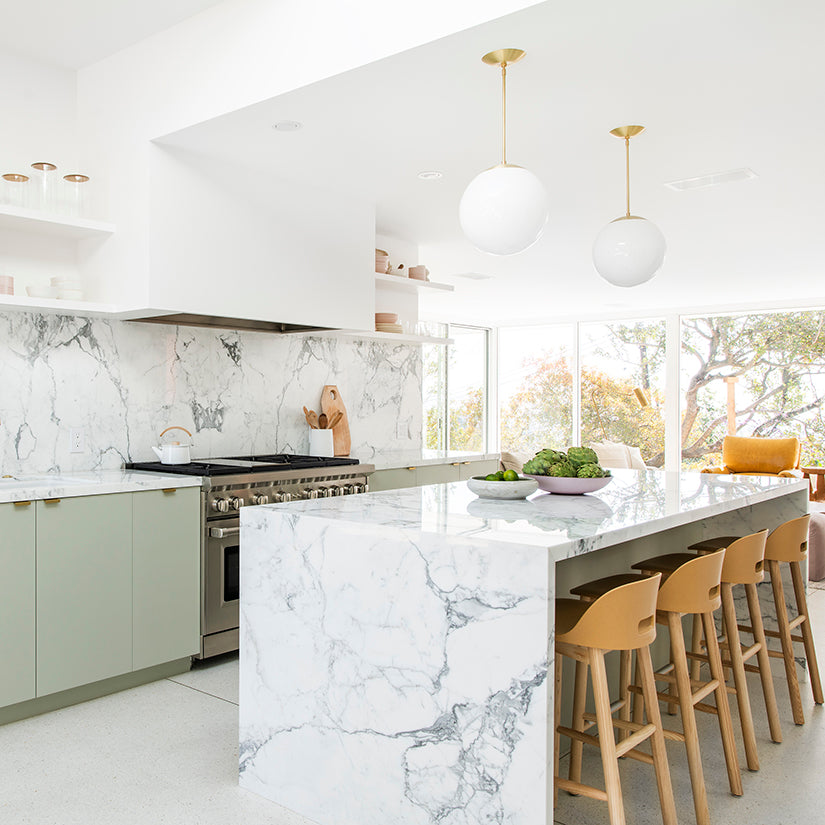
Marie Petite Sconce shown in Heirloom Brass. Interior design by Design Assembly.
Elevate Your Kitchen Lighting Design
The kitchen is the heart of a modern home. In the kitchen, where culinary creations and family gatherings intertwine, it's essential to prioritize your lighting design. In this article, we will guide you through the basics of lighting one of the most essential rooms in your home and help you create a room that radiates warmth and wonder.
Types of Light
When designing any room, consider three essential types of lighting: ambient, task, and accent.
• Ambient Lighting
Ambient lighting is the primary illumination for the entire room. It is typically provided by ceiling fixtures such as flush mounts, recessed lighting, and natural light. A room featuring large windows and more natural light will need fewer fixtures than a room with few or small windows. Take note of the sunlight patterns in your kitchen throughout the day. Observe the areas that have dark spots and think about what type of light fixture would help balance the illumination in that area.
• Task Lighting
Task lighting is strategically placed to target specific areas where activities such as cooking or prep work take place. You likely spend a lot of time at these stations. Take inventory of areas, including countertops, sinks, and cutting boards. Shadows created from a misplaced light fixture can make it difficult to work safely and efficiently. Supplement natural and overhead lighting with task lighting to enhance visibility and functionality in these areas. Examples of task lighting in the kitchen include wall sconces placed above countertops, a flush mount fixture over a sink, or pendant lights over a kitchen island.
• Accent Lighting
Accent lighting enhances your kitchen's atmosphere, highlighting architectural and decorative elements. Installing sconces above open shelving can establish a captivating focal wall. A striking pendant in a breakfast nook can showcase your distinctive style to guests. Consider layering with under-cabinet lighting for dark, hard to reach recesses.

Summit 12" shown in Heirloom Brass. Interior Design by Corvino Design. Photo by Nicole Franzen.
Design to the Style of Your Home
Your personal design preferences and the overall style of your kitchen should guide your lighting choices, seamlessly integrating with the existing decor.
• Ceiling Height and Shape
Choose fixtures that suit your ceiling's height and shape. Vaulted ceilings may need special consideration. Choose a corded fixture or one that can be customized with a hang straight, swivel, or hinge to accommodate the angle of your ceiling.
• Layered Lighting and Scale
• Harmonizing Finishes
Your personal design preferences and the overall style of your home should guide your finish choices. You may appreciate classic finishes such as brass or graphite patina or you may embrace a pop of color. Whichever finish you prefer, make it your own. You may also consider incorporating complementary materials such as glass, wood, or ceramic for added texture and visual interest. If you are uncertain, ordering finish samples can help coordinate your design scheme.
Alto Rod 12" pendant shown in Brass. Interior design by Sarah Sherman Samuel.
Final Thoughts
Your lighting choices should reflect your personal style and preferences. Layer lighting in the room using ambient, task, and accent lighting to supplement and enhance natural light. Select lighting that complements your kitchen's style, finishes, and scale. Whether you prefer a traditional or modern look, explore options that suit your taste and transform your kitchen into a well-lit, inviting space. Discover more kitchen inspiration by exploring our Lookbook and see how our clients around the globe incorporate Cedar & Moss fixtures into their stylish sanctuaries.






